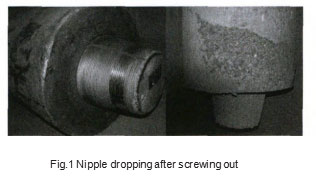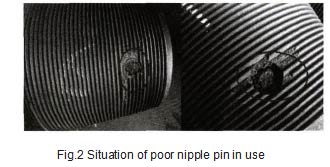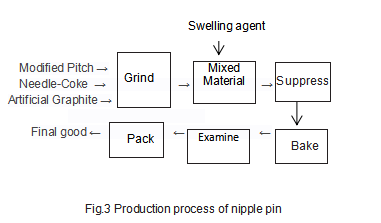The study of nipple pins for UHP graphite electrode

Since the invention of EAF steel-making method in 1899, EAF steel-making has become the main process for smelting special steel after more than 100 years of development. Graphite electrode is an irreplaceable high-temperature conductive material for electric arc furnace steelmaking because of its excellent conductivity and heat conduction properties, good toughness, strong current impact resistance, high temperature non-softening and non-melting, easy processing and convenient production and use. In recent years, with the rapid development of economy, the demand for special steel is more and more extensive, leading to the rapid development of EAF steelmaking technology, large capacity, high power EAF and large furnace refining technology has become the symbol of modern steel industry. According to the rated capacity of electric arc furnace transformer, International Iron and Steel Institute (IISI) recommends 100 ~ 200 kVA/t for low power electric arc furnace, 201 ~ 400 kVA/t for medium power electric arc furnace, 401 ~ 700 kVA/t for high power electric arc furnace, 701 ~ 1 000 kVA/t are ultra-high power arc furnaces . The electrodes matched with the furnace are RP (ordinary power) graphite electrode and HP (high power) graphite electrodes and UHP (ultra high power) graphite electrodes respectively.
In the use of graphite electrode, several electrodes are usually connected into electrode column through a joint. Graphite electrode joint adopts conical joint and triangular thread. Such thread contact area is large, so as to realize a firm connection by using the friction force between threads. The corresponding connection tightening torque is stipulated for different specifications of electrodes. But compared with the cylindrical joint, the phenomenon of backdating is more serious. Especially the ultra-high power arc furnace has the characteristics of low voltage, high current and high energy density. Due to the strong continuous arc induced vibration, considerable force is periodically applied on the electrode column, which easily causes the joint to buckle. In addition, the swing caused by the up and down adjustment of the electrode column and the impact of the charge in smelting will aggravate the loosening and buckling of the threaded connection between the electrode and the joint, causing the electrode column to fall off or break, as shown in Figure 1.

In order to prevent the loosening and retracting of the electrode during use, the main measures taken by the electrode manufacturers are the joint bolt (pressing or filling) and the joint paste (round sheet), joint pin, joint powder, adhesive, etc., is currently commonly used in the form of joint bolt. In recent years, China Kaifeng Carbon CO., Ltd. China Pingmei Shenma Group has been outsourcing the joint plug, and the use effect is not ideal. The joint plug almost does not flow out of the plug hole, and the effect of consolidation of the joint and electrode is not achieved, as shown in the circular frame in Figure 2.

The joint bolt should meet the following conditions in the process of use: first, it is to have good fluidity, foaming expansion performance, at 150~250 ℃ can be quickly distributed to the electrode and the thread of the joint; Second, it is to be able to form enough cohesive coking, and cohesive coking to have enough strength; Third, it can be transformed into materials with good electrical conductivity as the temperature rises. Therefore, through the analysis of the actual use of the joint bolt in the steel mill, and consulting the literature, and then develop the test program, implementation program, test results comparison, program optimization, the development of UHP graphite electrode joint bolt, and track the use of samples in 150 t ultra-high power electric furnace.
1 Test
1.1 Selection of raw materials
The traditional joint plug often uses ordinary petroleum coke as the main raw material. Compared with needle coke, ordinary petroleum coke has the disadvantages of poor electrical conductivity, large oxidation loss at 600-800 ℃ and easy particle peeling. According to the characteristics of good fluidity and expansibility at lower temperature and good consolidation and electrical conductivity at higher temperature, graphite powder, calcined coal series needle coke powder, hard asphalt and expansion agent were selected as raw materials.
1) Graphite powder and coke powder
The joint bolt should meet the following conditions in the process of use: first, it is to have good fluidity, foaming expansion performance, at 150~250 ℃ can be quickly distributed to the electrode and the thread of the joint; Second, it is to be able to form enough cohesive coking, and cohesive coking to have enough strength; Third, it can be transformed into materials with good electrical conductivity as the temperature rises. Therefore, through the analysis of the actual use of the joint bolt in the steel mill, and consulting the literature, and then develop the test program, implementation program, test results comparison, program optimization, the development of UHP graphite electrode joint bolt, and track the use of samples in 150 t ultra-high power electric furnace.
2) Hard asphalt
Coal asphalt is a thermoplastic material, within 140 ~ 250 ℃ with good mobility, and belongs to the hydrophilic material, and artificial graphite, needle coke properties similar, at high temperature can form a high strength of coke, hard asphalt has a higher coking value than medium temperature asphalt, suitable for the production and application of joint plug. Physical and chemical indexes of hard coal pitch are shown in Table 2.
Table 1 Physical and chemical indicators of graphite powder
and coke powder
Raw Material Stone | Density/(g/cm3) | Ash/% | Purity/% |
Toner Salcined | 2.22 | 0.11 | 70~80 |
Coke Powder | 2.13 | 0.13 | 70~80 |
Note: Purity refers to the particle size content below 200 mesh.
Table 2 Performance index of hard pitch %
Raw Material | tSP/℃ | Ash | TI | QI | β Resin | CV |
Hard pitch | 106 | 0.20 | 30.1 | 8.6 | 21.5 | 56.3 |
Note: The softening point tSP is tested by the ring and ball method.
3) Expansion agent
The expansion agent can produce a lot of gas when the asphalt is low in viscosity, so that the joint paste can quickly flow out of the plug hole and fill the space between the threads. The index requirements of the expansion agent are shown in Table 3.
Table 3 Indicator requirements of expanding agent %
Raw Material | Ash | Carbonaceous | Moisture | Purity | Granularity/μm |
Swelling agent | 0.08 | 0.12 | 0.10 | 99.5 | <150 |

No related results found








0 Replies